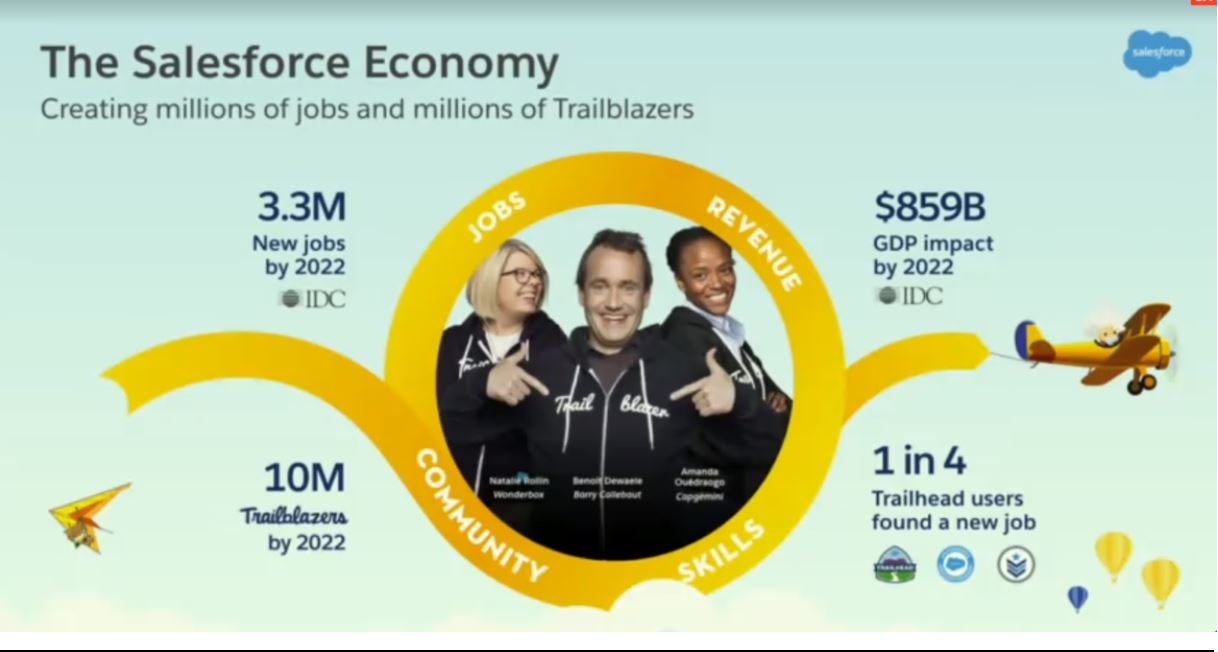
Web Developers
The Coresight Research team attended the Dreamforce software conference and analyst day hosted by software firm Salesforce, which was held September 25–28 in San Francisco.This report is on our takeaways from Salesforce management’s presentations that were made to analysts as well as from presentations made too ther participants at the event. We divide our takeaways into two sections: those on Salesforce and those on the tech industry more broadly.
Harris proposed the following four levers for change to counter such manipulation:
Hearing About Salesforce
Tools that Deliver Seamless Customer Experiences
In a “fireside chat” at the event, Salesforce President and Chief Product Officer Bret Taylor pointed to how two Salesforce products—Salesforce Customer 360 and Salesforce Einstein—will help companies build seamless customer experiences. Given below are brief descriptions of these products:- Salesforce Customer 360 gives companies a 360-degree view of customers by delivering deeper customer service insights. Its provides companies with a single-window view of customers and helps them deliver seamless customer experiences across channels by providing customer service agents with the tools and intelligence needed to move at customers’ speed. This tool is in closed pilot release at present and is scheduled for general availability in 2019.
- Einstein is an AI-powered predictive platform that has the predictive powers required by customer service agents to “get in front of customer problems”—by, for instance, fixing something before it breaks—to create “brand-defining moments.” Most companies today process large amounts of customer data,and Einstein learns from that data to deliver predictions and recommendations based on users’ business processes. This product comes with Einstein Voice which allows users to engage with Salesforce via voice assistance.
- Marc Benioff, Salesforce founder and CEO,has a “beginner’s mind” and is more creative “than any (other) leader,” according to Taylor; and
- Keith Block, co-CEO since August 2018, who is a “values-driven” operator who “calms everything down” and is very transparent.
Serving Up Data in the Fourth Industrial Revolution
Takeaways from the plenary presentations made at the event include:- Tyler Prince, EVP of Worldwide Alliances and Go-to-Market Innovation at Salesforce, flagged up the economic value that the use of Salesforce can create. According to research by International Data Corporation (IDC), the “Salesforce economy” will create 3.3 million new jobs and make a $859-billion impact on GDP by 2022 (Figure 1). This positive impact will be made by up to 300,000 consultants that Salesforce will have by that year.
- Block spoke of the ongoing “fourth industrial revolution,” which is powered by digitalization. There is legacy data in every industry, Block said, and this gives Salesforce the opportunity to unlock it and “serve it up” to improve customer experience across industries. The critical issue, he continued,for Salesforce is keeping up with demand, and it is the “perfect storm” in which the company’s impact could go much further than just business by helping people to rethink the world and core nonbusiness elements such as citizenship and governments.
- Neeracha Taychakhoonavudh, SVP of Industries at Salesforce, said there was an approximately $80 billion addressable market for Salesforce. According to Taychakhoonavudh, $26 billion of that market is the opportunity to sell to its traditional heartland of B2B customers, while a further $55 billion lies in the potential B2C customers of Salesforce. She further pointed out that 88% of the total addressable market is in the seven industries that Salesforce is focused on.
 According to Prince, the “Salesforce economy” will create 3.3 million new jobs and make a $859-billion impact on GDP by 2022
Source: Salesforce
According to Prince, the “Salesforce economy” will create 3.3 million new jobs and make a $859-billion impact on GDP by 2022
Source: Salesforce
Hearing About the Tech Industry
Get Ready for the Fourth Wave of AI
Richard Socher, Chief Scientist at Salesforce, and Kai-Fu Lee, Chairman and CEO at Sinovation Ventures, discussed how AI will transform businesses. Socher noted that people must separate hype— such as on the notion of self-determining AI—from reality. We do not yet have self-conscious algorithms that decide their own goals and change their own functions, and we do not yet have a credible research path to such algorithms, he said. Yet, Socher continued, we are seeing AI becoming much more accessible, including through open-source coding. AI needs three things: data, algorithms and workflows. Data tends to be unique to companies and algorithms are becoming more commoditized through open source, but workflows can be complex and hard to understand—for instance, an AI-powered self-driving car or chatbot must know when human intervention is necessary. Lee said that the evolution of AI comprises the following four waves and we are in the third wave at present:- The first wave came when companies and consumers adopted the Internet, which made large volumes of data available for the development of AI.
- The second wave saw companies adopt AI, for example, in software for financial and health companies. This wave saw data move from being cost centers(and burdensome requirements)to being “goldmines” that helped companies increase their ROIs, margins and customer conversion rates, and reduce costs.
- The third wave, which we are in at present,is one in which digitalized data from the real world is contributing to the development of AI. For example, Amazon Go, and other similar, stores make use of computer vision and deep learning algorithms, and devices such as Amazon Echo analyze speech. These “real-world” behaviors are being used in the development of autonomous stores, and they also have applications in retail, clinics and restaurants. Lee sees a future bifurcation between “maximum efficiency” delivered by robots at“low-end” convenience stores, supermarkets and restaurants with the cost dramatically reduced, and “high-end,” human-curated experiences.
- The fourth wave, according to Lee, will be the final wave and will feature autonomous AI. In other words, AI will control mechanical hands and feet and, therefore,will be able to work at jobs in the agriculture sector, manufacturing, inspection, security and cleaning, among others. Lee also said that dish washing robots and strawberry-picking robots are only 1–2 years away, though commentators have not yet agreed on more complex uses of AI such as in autonomous cars.
Making Technology More Humane
That “we need to stop technology (from) destabilizing the world”was the pitch from Tristan Harris, Cofounder at the Center for Humane Technology. He argued that tech platforms, especially social media firms, are engaged in an “arms race” for grabbing consumers’ attention and in doing so are pitching supercomputers against the human brain. For instance, Harris said, visitors to the YouTube website encounter a supercomputer that makes recommendations based on around 2 billion prior video views which are designed to keep them on the website. As a result, 70% of the total traffic on YouTube now comes via algorithm-driven recommendations and these recommendations have driven up the average time per session spent on YouTube to 60 minutes. Likewise, Facebook has deployed algorithms to make personalized suggestions of groups that a visitor can join because it wants to maximize engagement through group memberships. These firms “increasingly know us better than we know ourselves,” suggested Harris. Other challenges lie in social media’s impact on the young. Harris noted that Snapchat has upped user engagement through its beautification tools, which, he said, tells young users that they get more attention if they are beautiful. “We have got to stop screwing with kids’ identity development,” Harris said. Some 72% of US teens think that they are being manipulated to spend more time on their devices, according to a 2018 Common Sense Media survey. Many US teens believe tech companies are manipulating them
Source: Common Sense Media/Center for Humane Technology
Many US teens believe tech companies are manipulating them
Source: Common Sense Media/Center for Humane Technology
Harris proposed the following four levers for change to counter such manipulation:
- Activate the public, and especially parents;
- Activate employees at tech companies;
- Activate pressure from governments; and
- Inspire the alternative, with more human e-technology.